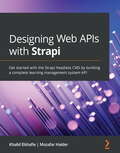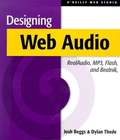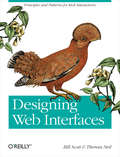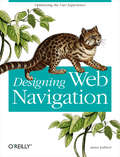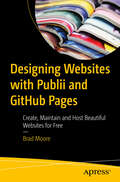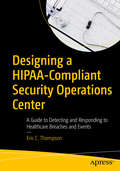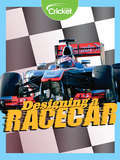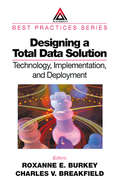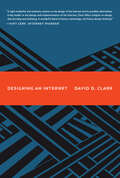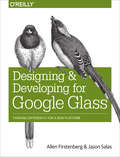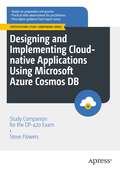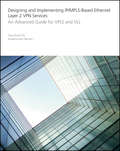- Table View
- List View
Designing Virtual Worlds Volume I
by Richard A. BartleDesigning Virtual Worlds, authored by a true pioneer, stands as the most comprehensive examination of virtual-world design ever written. This seminal work is a tour de force, remarkable for its intellectual breadth, encompassing the literary, economic, sociological, psychological, physical, technological, and ethical foundations of virtual worlds. It provides readers with a profound, well-grounded understanding of essential design principles.This first volume presents a rich, well-developed exploration of the foundational concepts underpinning virtual worlds. Tracing the evolution of such games from their inception, it draws upon examples ranging from the earliest MUDs to today's expansive MMORPGs. It elucidates fundamental design precepts often forgotten in the development of new games.No other book on online games or virtual worlds matches the level of detail, historical context, and conceptual depth found in Designing Virtual Worlds.
Designing Virtual Worlds: Volume I
by Richard A. BartleDesigning Virtual Worlds, authored by a true pioneer, stands as the most comprehensive examination of virtual‑world design ever written. This seminal work is a tour de force, remarkable for its intellectual breadth, encompassing the literary, economic, sociological, psychological, physical, technological, and ethical foundations of virtual worlds. It provides readers with a profound, well‑grounded understanding of essential design principles.This first volume of the second edition presents a rich, well‑developed exploration of the foundational concepts underpinning virtual worlds. Tracing the evolution of such games from their inception, it draws upon examples ranging from the earliest MUDs to todayʼs expansive MMORPGs. It elucidates fundamental design precepts often forgotten in the development of new games.No other book on online games or virtual worlds matches the level of detail, historical context, and conceptual depth found in Designing Virtual Worlds.
Designing Voice User Interfaces: Principles of Conversational Experiences
by Cathy PearlVoice user interfaces (VUIs) are becoming all the rage today. But how do you build one that people can actually converse with? Whether you’re designing a mobile app, a toy, or a device such as a home assistant, this practical book guides you through basic VUI design principles, helps you choose the right speech recognition engine, and shows you how to measure your VUI’s performance and improve upon it.Author Cathy Pearl also takes product managers, UX designers, and VUI designers into advanced design topics that will help make your VUI not just functional, but great.Understand key VUI design concepts, including command-and-control and conversational systemsDecide if you should use an avatar or other visual representation with your VUIExplore speech recognition technology and its impact on your designTake your VUI above and beyond the basic exchange of informationLearn practical ways to test your VUI application with usersMonitor your app and learn how to quickly improve performanceGet real-world examples of VUIs for home assistants, smartwatches, and car systems
Designing Web APIs with Strapi: Get started with the Strapi headless CMS by building a complete learning management system API
by Khalid Elshafie Mozafar HaiderLeverage the power of Strapi to build self-hosted, customizable, and performant content APIsKey FeaturesDiscover how Strapi can help you build APIs quickly and focus on your products and featuresLearn how to put Strapi into practice by implementing it in real-world scenariosUnderstand how to use Strapi's powerful features to customize your APIsBook DescriptionStrapi is a Node.js-based, flexible, open-source headless CMS with an integrated admin panel that anyone can use and helps save API development time. APIs built with Strapi can be consumed using REST or GraphQL from any client. With this book, you'll take a hands-on approach to exploring the capabilities of the Strapi platform and creating a custom API from scratch.This book will help JavaScript developers to put their knowledge to work by guiding them through building powerful backend APIs. You'll see how to effortlessly create content structures that can be customized according to your needs, and gain insights into how to write, edit, and manage your content seamlessly with Strapi. As you progress through the chapters, you'll discover a wide range of Strapi features, as well as understand how to add complex features to the API such as user authentication, data sorting, and pagination. You'll not only learn how to find and use existing plugins from the open-source community but also build your own plugins with custom functionality with the Strapi plugin API and add them to the admin panel. Finally, you'll learn how to deploy the API to Heroku and AWS.By the end of this book, you'll be able to build powerful, scalable, and secure APIs using Strapi.What you will learnExplore Strapi and understand how it worksDefine content types to build APIs quickly and efficientlyUnderstand authentication and authorization in StrapiCreate production-ready APIs with StrapiDeploy the Strapi API to various environments, including Heroku and AWSUse best practices to run the Strapi API in productionSync permissions to access the API between multiple environmentsWrite basic tests for API utilities as well as the endpointWho this book is forThis book is for backend and frontend JavaScript developers. Experienced API developers will learn a new, fast, and flexible way of building APIs, while frontend developers will be able to take a step toward becoming full-stack developers by learning how to leverage Strapi for building APIs quickly. Basic knowledge of JavaScript and REST API concepts is assumed.
Designing Web APIs: Building APIs That Developers Love
by Amir Shevat Brenda Jin Saurabh SahniUsing a web API to provide services to application developers is one of the more satisfying endeavors that software engineers undertake. But building a popular API with a thriving developer ecosystem is also one of the most challenging. With this practical guide, developers, architects, and tech leads will learn how to navigate complex decisions for designing, scaling, marketing, and evolving interoperable APIs.Authors Brenda Jin, Saurabh Sahni, and Amir Shevat explain API design theory and provide hands-on exercises for building your web API and managing its operation in production. You’ll also learn how to build and maintain a following of app developers. This book includes expert advice, worksheets, checklists, and case studies from companies including Slack, Stripe, Facebook, Microsoft, Cloudinary, Oracle, and GitHub.Get an overview of request-response and event-driven API design paradigmsLearn best practices for designing an API that meets the needs of your usersUse a template to create an API design processScale your web API to support a growing number of API calls and use casesRegularly adapt the API to reflect changes to your product or businessProvide developer resources that include API documentation, samples, and tools
Designing Web Audio
by Josh Beggs Dylan ThedeDesigning Web Audio is the most complete Internet audio guide on the market, loaded with informative real-world case studies and interviews with some of the world's leading audio and web producers. Its step-by-step instructions on how to use the most popular web audio formats to stream music make it an invaluable resource for web developers and web music enthusiasts.
Designing Web Interfaces: Principles and Patterns for Rich Interactions
by Theresa Neil Bill ScottWant to learn how to create great user experiences on today's Web? In this book, UI experts Bill Scott and Theresa Neil present more than 75 design patterns for building web interfaces that provide rich interaction. Distilled from the authors' years of experience at Sabre, Yahoo!, and Netflix, these best practices are grouped into six key principles to help you take advantage of the web technologies available today. With an entire section devoted to each design principle, Designing Web Interfaces helps you:Make It Direct-Edit content in context with design patterns for In Page Editing, Drag & Drop, and Direct SelectionKeep It Lightweight-Reduce the effort required to interact with a site by using In Context Tools to leave a "light footprint"Stay on the Page-Keep visitors on a page with overlays, inlays, dynamic content, and in-page flow patternsProvide an Invitation-Help visitors discover site features with invitations that cue them to the next level of interactionUse Transitions-Learn when, why, and how to use animations, cinematic effects, and other transitionsReact Immediately-Provide a rich experience by using lively responses such as Live Search, Live Suggest, Live Previews, and moreDesigning Web Interfaces illustrates many patterns with examples from working websites. If you need to build or renovate a website to be truly interactive, this book gives you the principles for success.
Designing Web Navigation
by James KalbachThoroughly rewritten for today's web environment, this bestselling book offers a fresh look at a fundamental topic of web site development: navigation design. Amid all the changes to the Web in the past decade, and all the hype about Web 2.0 and various "rich" interactive technologies, the basic problems of creating a good web navigation system remain. Designing Web Navigation demonstrates that good navigation is not about technology-it's about the ways people find information, and how you guide them. Ideal for beginning to intermediate web designers, managers, other non-designers, and web development pros looking for another perspective, Designing Web Navigation offers basic design principles, development techniques and practical advice, with real-world examples and essential concepts seamlessly folded in. How does your web site serve your business objectives? How does it meet a user's needs? You'll learn that navigation design touches most other aspects of web site development. This book: Provides the foundations of web navigation and offers a framework for navigation design Paints a broad picture of web navigation and basic human information behavior Demonstrates how navigation reflects brand and affects site credibility Helps you understand the problem you're trying to solve before you set out to design Thoroughly reviews the mechanisms and different types of navigation Explores "information scent" and "information shape" Explains "persuasive" architecture and other design concepts Covers special contexts, such as navigation design for web applications Includes an entire chapter on tagging While Designing Web Navigation focuses on creating navigation systems for large, information-rich sites serving a business purpose, the principles and techniques in the book also apply to small sites. Well researched and cited, this book serves as an excellent reference on the topic, as well as a superb teaching guide. Each chapter ends with suggested reading and a set of questions that offer exercises for experiencing the concepts in action.
Designing Websites with Publii and GitHub Pages: Create, Maintain and Host Beautiful Websites for Free
by Brad MooreDoes getting online seem overwhelmingly difficult? Are you paying too much for your hosting solution? Have you always wanted to have a blog but don’t know where to start? Do you settle for a Facebook page for your business website but know you need more? The solution to these problems is choosing the right tools. This book will guide you through the process of setting up a Publii-based publishing platform and hosting your site for free on GitHub. Publii is a free, open source, desktop application that runs on Windows, Mac, and Linux and makes building the website or blog you dream of is a simple process. This book walks you through the process of installing and using Publii, setting up accounts on GitHub and hosting a static blog or website there. You will gain background insights on here to get no-cost imagery for website, how to leverage AI to generate ideas, outlines, and images. You’ll also review search engine optimization (SEO) best practices to ensure your site is searchable. Designing Websites with Publii and GitHub Pages is your roadmap to creating a website and understanding how the publishing workflow works. What You Will Learn Use text editors such as WYSIWYG, Block, and Markdown Make a page from a post. Work on advanced processes such as installing themes and plugins Manage and back up your data Explore GDRP and cooking banner considerations Who This Book Is For Those with limited or no programming or compute skills who want to learn how to set up a website.
Designing With the Mind in Mind: Simple Guide to Understanding User Interface Design Guidelines
by Jeff JohnsonUser interface (UI) design rules and guidelines, developed by early HCI gurus and recognized throughout the field, were based on cognitive psychology (study of mental processes such as problem solving, memory, and language), and early practitioners were well informed of its tenets. But today practitioners with backgrounds in cognitive psychology are a minority, as user interface designers and developers enter the field from a wide array of disciplines. <p><p>HCI practitioners today have enough experience in UI design that they have been exposed to UI design rules, but it is essential that they understand the psychological basis behind the rules in order to effectively apply them. In Designing with the Mind in Mind, best-selling author Jeff Johnson provides designers with just enough background in perceptual and cognitive psychology that UI design guidelines make intuitive sense rather than being just a list of rules to follow.
Designing a Document Strategy
by Kevin CraineDesigning a Document Strategy, by Kevin Craine, MBA, is a book for managers, technicians and consultants who want to implement a document strategy for a large organization. The book describes a five-phase process that will guide readers through the design of document strategy tailored to their particular situations. Cause-effect diagrams, flow charts, and return on investment are presented in easy to understand terms. Case examples demonstrate how the methods in the book can be applied in the real world. As a result, readers are better prepared to take meaningful and informed action. Whatever decisions and recommendations readers ultimately make, they will be more likely to bring about real-world, bottom-line benefits. There is no better educational resource on designing a document strategy than this book.
Designing a HIPAA-Compliant Security Operations Center: A Guide to Detecting and Responding to Healthcare Breaches and Events
by Eric C. ThompsonDevelop a comprehensive plan for building a HIPAA-compliant security operations center, designed to detect and respond to an increasing number of healthcare data breaches and events. Using risk analysis, assessment, and management data combined with knowledge of cybersecurity program maturity, this book gives you the tools you need to operationalize threat intelligence, vulnerability management, security monitoring, and incident response processes to effectively meet the challenges presented by healthcare’s current threats. Healthcare entities are bombarded with data. Threat intelligence feeds, news updates, and messages come rapidly and in many forms such as email, podcasts, and more. New vulnerabilities are found every day in applications, operating systems, and databases while older vulnerabilities remain exploitable. Add in the number of dashboards, alerts, and data points each information security tool provides and security teams find themselves swimming in oceans of data and unsure where to focus their energy. There is an urgent need to have a cohesive plan in place to cut through the noise and face these threats. Cybersecurity operations do not require expensive tools or large capital investments. There are ways to capture the necessary data. Teams protecting data and supporting HIPAA compliance can do this. All that’s required is a plan—which author Eric Thompson provides in this book. What You Will Learn Know what threat intelligence is and how you can make it usefulUnderstand how effective vulnerability management extends beyond the risk scores provided by vendorsDevelop continuous monitoring on a budgetEnsure that incident response is appropriateHelp healthcare organizations comply with HIPAA Who This Book Is For Cybersecurity, privacy, and compliance professionals working for organizations responsible for creating, maintaining, storing, and protecting patient information.
Designing a New Class of Distributed Systems
by Rao MikkilineniDesigning a New Class of Distributed Systems closely examines the Distributed Intelligent Managed Element (DIME) Computing Model, a new model for distributed systems, and provides a guide to implementing Distributed Managed Workflows with High Reliability, Availability, Performance and Security. The book also explores the viability of self-optimizing, self-monitoring autonomous DIME-based computing systems. Designing a New Class of Distributed Systems is designed for practitioners as a reference guide for innovative distributed systems design. Researchers working in a related field will also find this book valuable.
Designing a Racecar
by Aaron MillarBefore the race even begins, engineers and designers have already been hard at work testing each and every part of a racecar.
Designing a Structured Cabling System to ISO 11801
by Barry J. ElliotCovering major standards and relevant design issues, this book explains how to specify, install, and test a modern reliable structured cabling system and analyzes the terminology and physics behind the standards. The author empowers the reader with the skills required to read and understand standards and address problems raised by the need to design, procure, install, and test a modern cabling system, using both copper and optical fiber cable technology. He thoroughly discusses the technology and the vast number of standards that accompany it. The material is based on the design recommendations of ISO/IEC 11801. The appendix lists relevant standards and provides contacts for standards organizations.
Designing a Total Data Solution: Technology, Implementation, and Deployment (Best Practices Ser.)
by Roxanne E. Burkey Charles V. BreakfieldYour company's global competitiveness depends on the utilization and maintenance of information. Current data handling practices-storing, updating, and accessing data-can be either a problem or a significant strategic advantage for your company. Designing a Total Data Storage Solution: Technology, Implementation, and Deployment gives you the inform
Designing an Internet (Information Policy)
by David D. ClarkWhy the Internet was designed to be the way it is, and how it could be different, now and in the future.How do you design an internet? The architecture of the current Internet is the product of basic design decisions made early in its history. What would an internet look like if it were designed, today, from the ground up? In this book, MIT computer scientist David Clark explains how the Internet is actually put together, what requirements it was designed to meet, and why different design decisions would create different internets. He does not take today's Internet as a given but tries to learn from it, and from alternative proposals for what an internet might be, in order to draw some general conclusions about network architecture. Clark discusses the history of the Internet, and how a range of potentially conflicting requirements—including longevity, security, availability, economic viability, management, and meeting the needs of society—shaped its character. He addresses both the technical aspects of the Internet and its broader social and economic contexts. He describes basic design approaches and explains, in terms accessible to nonspecialists, how networks are designed to carry out their functions. (An appendix offers a more technical discussion of network functions for readers who want the details.) He considers a range of alternative proposals for how to design an internet, examines in detail the key requirements a successful design must meet, and then imagines how to design a future internet from scratch. It's not that we should expect anyone to do this; but, perhaps, by conceiving a better future, we can push toward it.
Designing and Developing Robust Instructional Apps
by Kenneth J. LuterbachDesigning and Developing Robust Instructional Apps advances the state of instructional app development using three learning paradigms for building knowledge foundations, problem-solving, and experimentation. Drawing on research and development lessons gleaned?from noted educational technologists, time-tested systematic instructional design processes, and results from user experience design, the book considers the planning and specification of instructional apps that blend media (text, images, sound, and moving pictures) and instructional method. Further, for readers with little to no programming experience, introductory treatments of JavaScript and Python, along with data fundamentals and machine learning techniques, offer a guided journey that produces robust instructional apps and?concludes with next steps for advancing the state of instructional app development.
Designing and Developing for Google Glass: Thinking Differently for a New Platform
by Allen Firstenberg Jason SalasCreating apps for Google Glass is more involved than simply learning how to navigate its hardware, APIs, and SDK. You also need the right mindset. While this practical book delivers the information and techniques you need to build and deploy Glass applications, it also helps you to think for Glass by showing you how the platform works in, and affects, its environment.In three parts—Discover, Design, and Develop—Glass pioneers guide you through the Glass ecosystem and demonstrate what this wearable computer means for users, developers, and society as a whole. You’ll learn how to create rich functionality for a consumer technology that’s radically different than anything currently available.Learn the Five Noble Truths of great Glassware designUnderstand the Glass ecosystem and learn why it’s differentSidestep Glass’s societal concerns in your projectsLearn how Glass adapts to the user’s world, rather than the other way aroundAvoid poor design by identifying Glassware antipatternsBuild cloud services with the Google Mirror APIUse the Glass Development Kit to develop client applicationsSubmit your project for review in the MyGlass directory
Designing and Implementing Cloud-native Applications Using Microsoft Azure Cosmos DB: Study Companion for the DP-420 Exam (Certification Study Companion Series)
by Steve FlowersThis book will help prepare you for the Microsoft DP-420 exam. Whether you are new to Azure Cosmos DB or have experience working with the platform, Designing and Implementing Cloud-Native Applications Using Microsoft Azure Cosmos DB is organized to address the specific skills measured in the DP-420 exam. The topics covered include NoSQL models, code, and real-world scenarios aimed at helping you to understand and solve the case studies included in the exam. Beyond the exam, this book will assist you in your journey to adopt Microsoft Azure Cosmos DB for your own projects. You’ll learn what makes Azure Cosmos DB such a robust NoSQL service, as well as how NoSQL approaches help enable modern applications. You’ll also get practical guidance for your own implementations. The topics covered in this book are essential to knowing how to leverage the Cosmos DB service and provide best practices that will guide you to success both on the exam and in your career. What You Will Learn Understand and hone the skills needed to pass the DP-420 examGain insight into the test-taking experience, whether at a testing center or virtuallyEvaluate and understand features of Azure Cosmos DB using real-world use cases and code samplesLearn from case studies in the book that will help you to correctly address case studies in the examBuild a foundation that goes beyond the exam and gives you the confidence to implement Azure Cosmos DB in your own projectsDetermine the trade-offs between different configurations, whether your implementation is small and local or large and requires global scale Who This Book Is For Anyone planning to take the DP-420 exam, as well as developers, engineers, and architects seeking a better understanding of Azure Cosmos DB and how it is used in developing modern applications using a NoSQL approach.
Designing and Implementing IP/MPLS-Based Ethernet Layer 2 VPN Services: An Advanced Guide for VPLS and VLL
by Zhuo XuA guide to designing and implementing VPLS services over an IP/MPLS switched service provider backbone Today's communication providers are looking for convenience, simplicity, and flexible bandwidth across wide area networks-but with the quality of service and control that is critical for business networking applications like video, voice and data. Carrier Ethernet VPN services based on VPLS makes this a reality. Virtual Private LAN Service (VPLS) is a pseudowire (PW) based, multipoint-to-multipoint layer 2 Ethernet VPN service provided by services providers By deploying a VPLS service to customers, the operator can focus on providing high throughput, highly available Ethernet bridging services and leave the layer 3 routing decision up to the customer. Virtual Private LAN Services (VPLS) is quickly becoming the number one choice for many enterprises and service providers to deploy data communication networks. Alcatel-Lucent VPLS solution enables service providers to offer enterprise customers the operational cost benefits of Ethernet with the predictable QoS characteristics of MPLS. Items Covered: Building Converged Service Networks with IP/MPLS VPN Technology IP/MPLS VPN Multi-Service Network Overview Using MPLS Label Switched Paths as Service Transport Tunnels Routing Protocol Traffi c Engineering and CSPF RSVP-TE Protocol MPLS Resiliency — Secondary LSP MPLS Resiliency — RSVP-TE LSP Fast Reroute Label Distribution Protocol IP/MPLS VPN Service Routing Architecture Virtual Leased Line Services Virtual Private LAN Service Hierarchical VPLS High Availability in an IP/MPLS VPN Network VLL Service Resiliency VPLS Service Resiliency VPLS BGP Auto-Discovery PBB-VPLS OAM in a VPLS Service Network
Designing and Implementing Linux Firewalls and QoS using netfilter, iproute2, NAT and l7-filter
by Lucian GheorgheThe author draws on his experience to offer the reader valuable advice on the best practices. Providing only necessary theoretical background, the book takes a practical approach, presenting case studies and plenty of illustrative examples. This book is aimed at Linux Network administrators with some understanding of Linux security threats and issues, or any one interested in securing their systems behind a firewall. Basic knowledge of Linux is presumed but other than that this book shows you how to do the rest, from configuring your system to dealing with security breaches.
Designing and Implementing Microsoft DevOps Solutions AZ-400 Exam Guide: Prepare for the certification exam and successfully apply Azure DevOps strategies with practical labs, 2nd Edition
by Henry Been Maik van Gaag Subhajit Chatterjee Swapneel DeshpandeWritten by Microsoft MVPs and Azure experts, this comprehensive guide comes with self-study exercises to help you understand the concepts better and move closer to becoming a skilled Azure DevOps engineerKey FeaturesExplore a step-by-step approach to designing and creating a successful DevOps environmentUnderstand how to implement continuous integration and continuous deployment pipelines on AzureIntegrate and implement security, compliance, containers, and databases in your DevOps strategiesBook DescriptionThe AZ-400 Designing and Implementing Microsoft DevOps Solutions certification helps DevOps engineers and administrators get to grips with practices such as continuous integration and continuous delivery (CI/CD), containerization, and zero downtime deployments using Azure DevOps Services.This new edition is updated with advanced topics such as site reliability engineering (SRE), continuous improvement, and planning your cloud transformation journey. The book begins with the basics of CI/CD and automated deployments, and then moves ahead to show you how to apply configuration management and Infrastructure as Code (IaC) along with managing databases in DevOps scenarios. As you make progress, you'll explore fitting security and compliance with DevOps and find out how to instrument applications and gather metrics to understand application usage and user behavior. This book will also help you implement a container build strategy and manage Azure Kubernetes Services. Lastly, you'll discover quick tips and tricks to confidently apply effective DevOps practices and learn to create your own Azure DevOps organization.By the end of this DevOps book, you'll have gained the knowledge needed to ensure seamless application deployments and business continuity.What you will learnGet acquainted with Azure DevOps Services and DevOps practicesDiscover how to efficiently implement CI/CD processesBuild and deploy a CI/CD pipeline with automated testing on AzureIntegrate security and compliance in pipelinesUnderstand and implement Azure Container ServicesEffectively close the loop from production back to developmentApply continuous improvement strategies to deliver innovation at scaleWho this book is forThe book is for anyone looking to prepare for the AZ-400 certification exam. Software developers, application developers, and IT professionals who want to implement DevOps practices for the Azure cloud will also find this book helpful. Familiarity with Azure DevOps basics, software development, and development practices is recommended but not necessary.
Designing and Implementing Microsoft Index Server
by Mark Swank Drew Kittel Drew SwankTripoli is an index server that allows companies to automate their indexing of crucial data. Its integration with Windows NT and Internet Information Server opens the doors to a large market of corporate NT and IIS users that will want to automate their indexing. This book shows readers how to use Tripoli. Everything from installation to implementation is discussed in detail. * Show readers how to organize and maintain large amounts of information *Teaches ways to integrate the server into existing systems * Covers maintenance, administration, and security issues
Designing and Implementing Test Automation Frameworks with QTP
by Ashish BhargavaA tutorial-based approach, showing basic coding and designing techniques to build test automation frameworks.If you are a beginner, an automation engineer, an aspiring test automation engineer, a manual tester, a test lead or a test architect who wants to learn, create, and maintain test automation frameworks, this book will accelerate your ability to develop and adapt the framework.


